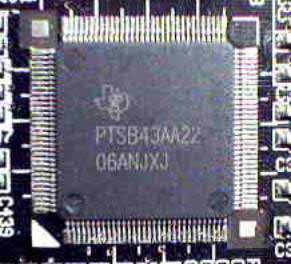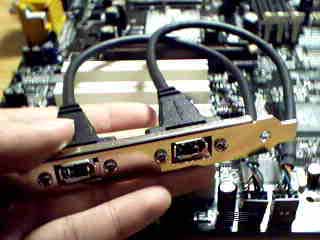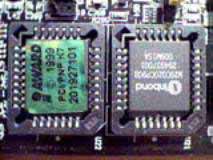AOpen AK73-1394 Socket-A KT133 ATX
by Mike Andrawes on January 21, 2001 3:29 AM EST- Posted in
- Motherboards
The Features
 The
VIA 8363 North Bridge sits to the left of the CPU socket, covered by the typical
AOpen platinum plated heat sink used on their top of the line boards. The 8363
is the core of the KT133 chipset and provides all the major features of the
KT133, including the 100 / 133MHz memory bus as well as AGP 4X support. The
AGP Slot is a "universal slot," which means it is not keyed specifically
for AGP 2X or AGP 4X cards, so you can install almost any current AGP card in
the slot. At the end of the AGP slot, AOpen also makes use of a locking mechanism
similar to the one by used by EPoX, that helps hold the AGP card in place during
shipping. It is a small clip that works similar to that of a DIMM slot clip
– it simply clips into a small tab at the end of the AGP card.
The
VIA 8363 North Bridge sits to the left of the CPU socket, covered by the typical
AOpen platinum plated heat sink used on their top of the line boards. The 8363
is the core of the KT133 chipset and provides all the major features of the
KT133, including the 100 / 133MHz memory bus as well as AGP 4X support. The
AGP Slot is a "universal slot," which means it is not keyed specifically
for AGP 2X or AGP 4X cards, so you can install almost any current AGP card in
the slot. At the end of the AGP slot, AOpen also makes use of a locking mechanism
similar to the one by used by EPoX, that helps hold the AGP card in place during
shipping. It is a small clip that works similar to that of a DIMM slot clip
– it simply clips into a small tab at the end of the AGP card.
The three DIMM slots on the AK73-1394 support a maximum of 1.5GB SDRAM. One feature of the VIA KT133 memory controller is that it allows users to run their memory at either 100MHz or 133MHz. Therefore, users with PC133 SDRAM can take advantage of the increased memory bandwidth over PC100 SDRAM (1.06GB/s vs 800MB/s). This can be done easily from within the BIOS by choosing either a 100MHz or a 133MHz memory clock. There is also the standard CAS Latency setting in the BIOS for further performance tweaking; here, the lower the value, the higher the performance.
The AK73-1394 also uses the VIA 686B South Bridge, which is pin compatible with the 686A, but adds Ultra ATA 100 support. They both have a second USB controller hub and an integrated PCI to ISA bridge. At this point, there is no hard drive out there with a sustained transfer rate greater than 40MB/sec, so the Ultra ATA 100 interface is not really necessary. However, with the current pace of technology, we don't think it will be too long before that barrier is broken, making it a definite plus for the motherboard to include Ultra ATA 100 support. The Ultra ATA 100 controller provides two IDE channels that support up to 4 IDE devices (two per channel).
Two traditional USB ports are mounted at the back of the motherboard together with the serial / parallel ports, and there are connectors ready for a third and fourth USB port the front of the board. In order to help users take advantage of the extra USB connectors, AOpen includes a bracket with two USB ports, so that users can setup their third and fourth USB ports easily.
What makes the AK73-1394 different from the AK73 Pro featur- wise is the inclusion of a IEEE 1394 (Firewire) controller. In the past, adding Firewire was an expensive proposition from a manufacturers perspective since the controllers were all two-chip solutions. However, since our visit to Comdex last year, we have noticed several new motherboards with single-chip Firewire solutions. That could help to reduce the cost and make Firewire more affordable for manufacturers to integrate.

TI's single-chip Firewire
That’s exactly the case with the AK73-1394, which uses a single-chip Firewire solution based on the Texas Instrument PTSB43AA22. It supports two Firewire channels with the two connectors located at the left edge of the motherboard. AOpen has also included the necessary bracket so that users can take advantage of the Firewire support out of the box.

This is the first board AnandTech has received featuring a single-chip IEEE 1394 Firewire solution. With this new, cheaper solution, we expect to see this feature implemented on more and more motherboards in the near future.
The 5/1/1/0 (PCI/AGP/AMR/ISA) expansion slot configuration on the AK73-1394 should be enough for most users, though it is definitely not the most flexible one. For starters, the AMR slot is more or less useless for most AnandTech readers. The 5 PCI slots should be enough, but we have seen motherboards with 6 PCI slots by using a PCI arbiter chip, giving more expansion flexibility. Moreover, the lack of an ISA slot also eliminates this motherboard from the shopping list of users who still have a few old ISA devices.
The AK73-1394 uses the Analog Devices 1885 AC’97 CODEC to provide basic on-board sound. This AC'97 audio provides some basic sound functionality for users on a budget, but for those who are serious about sound should definitely go for a true hardware-based PCI solution.

The AK73-1394 also comes with the famous AOpen Die Hard BIOS setup. Basically AOpen puts two BIOS chips on the board. For most of the time, only one of the two BIOS chips is active. If the BIOS chip is corrupted during a BIOS update or a virus attack, you can activate the backup BIOS via a jumper, allowing you to boot the machine.

Regarding installation, AOpen figured out a way to accommodate users with varying experience levels. Inside the AK73-1394, you can find a poster, which contains steps for easy installation and setup of the motherboard. On the other hand, the manual contains all the exact details on the motherboard and is simply excellent. It contains all the information on jumpers, connectors, as well as dip switches. It also talks about the installation of the board, CPU, and memory. Detailed explanation of each BIOS setting makes this manual a very good read, as it also contains a lot of technical explanation on the design of the motherboard.
There are two CDs bundled with the motherboard. One contains all the drivers and utilities you will need for setting up the motherboard and sound devices. The second CD is the Norton Antivirus 6.0. Many other manufacturers include older versions of this software, but AOpen makes sure they include a more recent version.










0 Comments
View All Comments